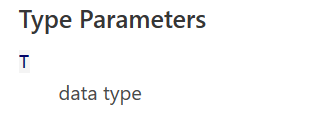C# API 文档注释规范
C# API 文档注释规范
- 1. 命名空间注释(namespace)
- 2. summary
- 3. remarks and para
- 4. param
- 5. returns
- 6. example and code
- 7. exception
- 8. typeparam
最近在开发工作中需要实现 API 帮助文档,如果根据所写的代码直接重写 API 帮助文档将会是意见非常大的工作量,如果根据所写的代码直接生成 API 帮助文档,将会大大减少工作量。Sandcastle Help File Builder可以实现上述需求。如果想要生成一个比较全面的 API 帮助文档,就需要对 C# 代码做一个比较全面的注释。在本文中,将根据Sandcastle Help File Builder 文档对 C# 代码注释做一个简单的总结。
1. 命名空间注释(namespace)
XML 注释不能直接应用于代码中的命名空间。因此,必须采取 指定命名空间注释的替代方法。
在源代码中,向每个命名空间添加一个空的 NamespaceDoc 类,当生成 XML 注释文件时,它们将用作命名空间注释。若要防止 NamespaceDoc 类出现在帮助文件中,请省略public关键字,并使用 CompilerGenerated 属性对其进行标记。 这将导致在为程序集生成反射信息时自动忽略该类。 下面是一个示例:
namespace OpenVinoSharp
{
///
/// These are the namespace comments for OpenVinoSharp .
///
[System.Runtime.CompilerServices.CompilerGeneratedAttribute()]
class NamespaceDoc
{
}
}
2. summary
用于提供类型或成员的简要说明,对所有类型和类型成员都有效。格式如下:
/// <summary>
/// function/claee/enmu description
/// summary>
例如:
///
/// Global functions under ov namespace
///
public static partial class Ov
{}
在使用Sandcastle Help File Builder生成帮助文档后显示:
3. remarks and para
remarks:用于提供类型或成员的更详细说明,对所有类型和类型成员都有效。格式如下:
parade:用于在其他元素中开始一个新段落。格式如下:
/// <remarks>
/// dfunction/claee/enmu description
/// remarks>
例如:
///
///
/// For IR format (*.bin):
/// if `bin_path` is empty, will try to read a bin file with the same name as xml and
/// if the bin file with the same name is not found, will load IR without weights.
/// For the following file formats the `bin_path` parameter is not used:
///
/// ONNX format (*.onnx)
/// PDPD(*.pdmodel)
/// TF(*.pb)
/// TFLite(*.tflite)
///
public Model read_model(string model_path, string bin_path = "")
在使用Sandcastle Help File Builder生成帮助文档后显示:
4. param
用于描述方法参数。对描述每个参数的方法和运算符重载有效。参数名称是被引用的参数的名称。格式如下:
/// <param name="paramName">
/// Parameter description
/// param>
例如:
/// String with a model in IR / ONNX / PDPD / TF / TFLite format.
/// Shared pointer to a constant tensor with weights.
public Model read_model(string model_path, Tensor weights)
在使用Sandcastle Help File Builder生成帮助文档后显示:
5. returns
用于描述方法的返回值,对返回值的所有方法都有效。格式如下:
/// <returns>descriptionreturns>
例如:
/// InferRequest object
public InferRequest create_infer_request()
在使用Sandcastle Help File Builder生成帮助文档后显示:
6. example and code
example: 用于定义类型或其成员之一的示例,以显示如何使用它。对所有类型和成员都有效。说明是可选的。通常包含一个或多个代码元素以显示示例代码,为了更具描述性的文本,可以根据需要包含在代码元素之间。
code:用于指示应将多行文本部分格式化为代码块。格式如下:
/// <example>
/// Optional code description
/// <code language="C#">
/// Example code
/// code>
/// example>
例如:
///
/// when user data has 'NHWC' layout (example is RGB image, [1, 224, 224, 3]) but model expects
/// planar input image ('NCHW', [1, 3, 224, 224]). Preprocessing may look like this:
///
/// var proc = PrePostProcessor(model);
/// proc.input().tensor().set_layout("NHWC"); // User data is NHWC
/// proc.input().preprocess().convert_layout("NCHW")) // model expects input as NCHW
///
///
public PreProcessSteps convert_layout(Layout layout)
在使用Sandcastle Help File Builder生成帮助文档后显示:
7. exception
用于列出可由类型成员引发的异常。对属性、方法、事件、运算符和类型转换成员有效。异常类型是可以引发的异常类型的名称。格式如下:
/// <exception cref="exceptionType">descriptionexception>
例如:
/// If a model has more than one input, this method throws ov::Exception.
public Input input()
在使用Sandcastle Help File Builder生成帮助文档后显示:
8. typeparam
用于描述泛型类型和方法上的泛型参数。对泛型类型和泛型方法有效,用于描述每个泛型类型参数。类型参数名称是泛型类型参数的名称 引用。格式如下:
/// <typeparam name="T">Type parameter descriptiontypeparam>
例如:
/// data type
public void set_data(T[] input_data)
在使用Sandcastle Help File Builder生成帮助文档后显示:






